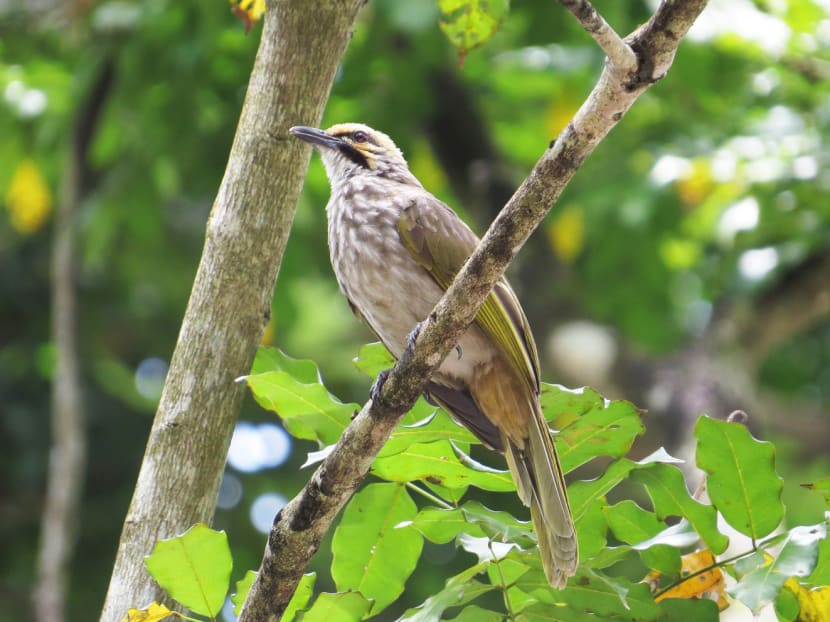Singapore one of few remaining strongholds for endangered songbird
SINGAPORE — The Republic can play a crucial role in conserving a songbird called the Straw-headed bulbul, whose numbers have been decimated in much of South-east Asia — the only region where it can be found, say local bird enthusiasts.
SINGAPORE — The Republic can play a crucial role in conserving a songbird called the Straw-headed bulbul, whose numbers have been decimated in much of South-east Asia — the only region where it can be found, say local bird enthusiasts.
The bird’s conservation status was yesterday raised to “endangered” from “vulnerable” on the International Union for Conservation of Nature (IUCN) Red List, which classifies species at high risk of global extinction.
The Straw-headed bulbul’s global numbers have plunged due to the illegal bird trade. From a 2001 estimate of 10,000 to 19,999 mature individuals in the wild, the estimate is now merely 600 to 1,700.
Known for its melodious and warbling song, the bird is considered locally extinct in Java, Thailand and possibly Sumatra, while numbers in Borneo and Peninsular Malaysia are in rapid decline. Each bird can fetch about US$500 (S$708) in the Indonesian market, according to current research.
In contrast, its numbers in Singapore are relatively secure due to low poaching pressures, and may even be increasing, said Mr Yong Ding Li of the Nature Society (Singapore) Bird Group, who is a PhD student at Australian National University.
Singapore is “one of the few remaining strongholds for the species”, which should be a high priority for the Republic’s conservation efforts, according to a recent report by wildlife trade monitoring network Traffic.
The Straw-headed bulbul is the most endangered songbird found in Singapore, said Traffic, which has highlighted the plight of South-east Asian songbirds threatened by demand from the caged-bird trade.
The latest IUCN Red List update saw 19 bird species in Asia moved to a higher threat category, including six to Critically Endangered, according to conservation partnership Birdlife International.
Two other affected species — the Greater green leafbird and Javan myna, from “least concern” to “vulnerable” — can be found here, but it is the Straw-headed bulbul whose plight is most dire.
The bird is listed on Appendix II of the Convention of International Trade in Endangered Species of Wild Fauna and Flora (Cites), which means trading requires a valid Cites export permit or re-export certificate. Singapore is a signatory to the convention.
There are at least 200 Straw-headed bulbuls in Singapore and its population is estimated to be increasing, based on research led by the Nature Society (Singapore), said Mr Yong.
A significant group of Straw-headed bulbuls can be found on Pulau Ubin, which could house the largest known population in a particular area, added Mr Yong, who led a study on its population patterns. Others involved in the study include conservationist Dr Ho Hua Chew and veteran birdwatchers Lim Kim Seng and Lim Kim Chuah, who are brothers.
The Straw-headed bulbul can be seen in Singapore year-round and is “quite sedentary”, said Mr Lim Kim Seng. “It likes to forage near water, yet water seems to be a significant barrier for its dispersal.”
This could explain why the bird has not been spotted in Pulau Tekong or the woodland remnants of Changi and Pasir Ris on mainland Singapore, despite the areas’ close proximity to Ubin.
“It has a very powerful song, one of the most characteristic bird sounds of South-east Asia,” added Mr Yong.
The Singapore birdwatchers want more conservation efforts here targeting the Straw-headed bulbul, which is not dependent on good-quality rainforest but has instead colonised many patches of secondary woodland.
The authorities could consider gazetting Ubin as a nature reserve to accord it the highest level of biodiversity protection, for instance, said Mr Yong, who is a member of the Red List Authority of the IUCN Species Survival Commission, which can flag a species for review if there is adequate field evidence that it is in decline.
The birdwatchers plan to monitor the Straw-headed bulbul’s population changes in Singapore, and assess the threat of poaching here. They also plan to push for a regional species management plan for the bird.
Mr Yong believes drastic measures are needed to save the Straw-headed bulbul — such as ensuring conditions for the survival of some wild populations, and bringing some into captivity at recognised zoological institutions.
Calling for greater enforcement against poaching, Mr Yong said a working group on the songbird could be set up for better sharing of information.







